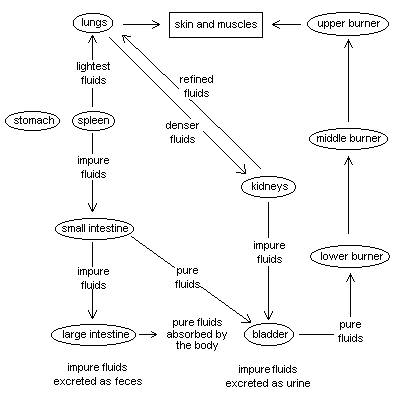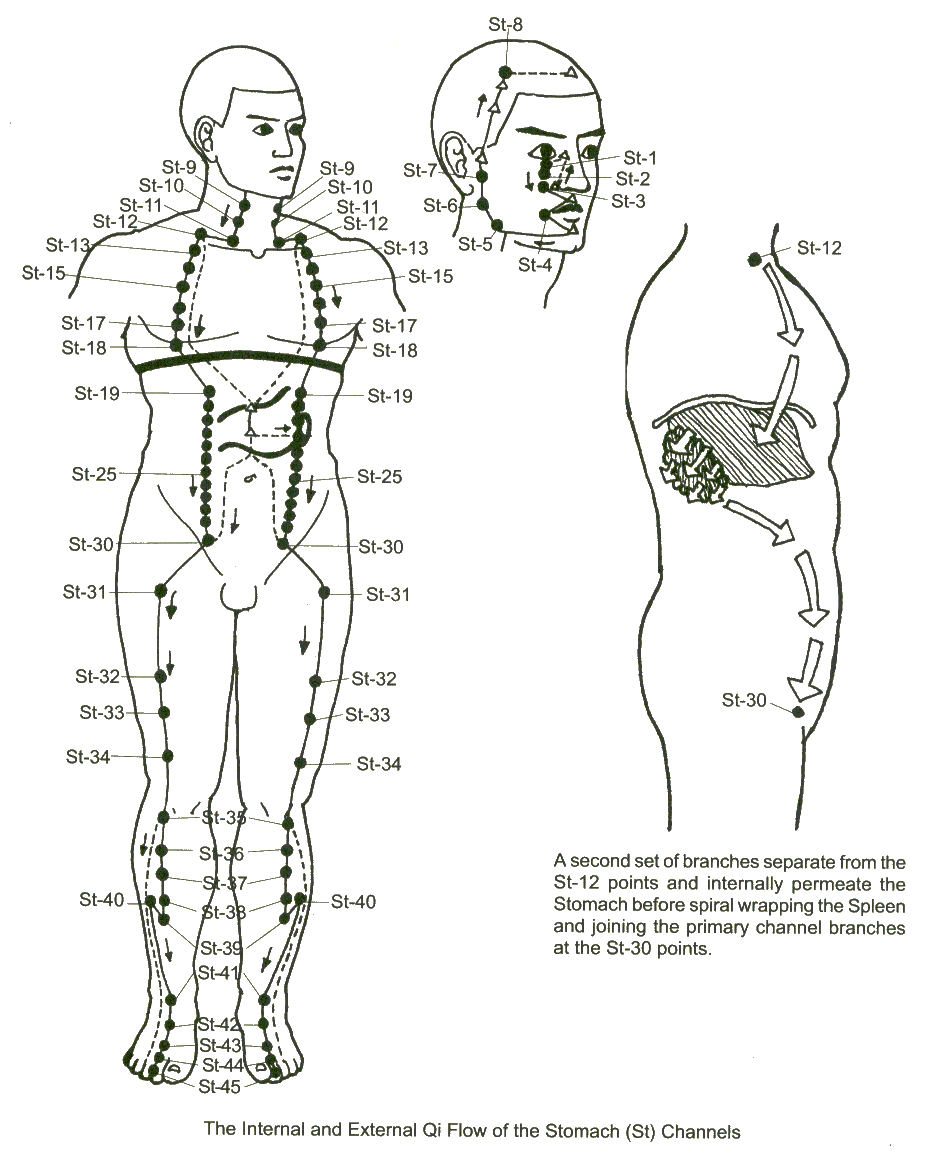
Stomach: Earth-energy yang organ
Stomach:
Earth-energy yang organ
The stomach is called the 'Minister of the Mill' and is also known as the 'Sea of Nourishment'. Because it is responsible for providing the entire system with postnatal energy from the digestion of food and fluids, it is regarded as the 'Root of Postnatal Life'. In addition to digesting bulk foods and fluids and moving them onwards to the small intestine for extraction and assimilation of nutrients, the stomach also extracts pure postnatal energy from foods and fluids, and in coordination with spleen energy it transports this food energy through the meridian system to the lungs, where it combines with air energy from breathing. This is a function of the stomach not acknowledged in Western medicine, which focuses only on the biochemistry of digestion and does not recognize the bioenergetic aspect.
Schematic of Chinese Fluid Physiology:

Governed by pivotal Earth energy, the stomach is responsible for extracting and balancing all Five Elemental Energies from foods and fluids ingested through the mouth, which it shares with the spleen as its external aperture. Any dysfunction of the stomach results in an immediate deficiency or imbalance in the nourishing energy channeled from the stomach to other organs.
|
Stomach |
|
| Paired Organ | Spleen |
| Color | deep yellow |
| Peak Hours | 7am-9am |
| Physical Branches | muscles, lips, mouth, saliva |
| Functions | digestion, absorption of postnatal energy |
Stomach: Psycho-Emotional Aspects
The Stomach influences the mental state; an Excess condition can agitate the mind and cause mental symptoms such as: mania or hypomania, confusion, severe anxiety, and hyperactivity.
The Stomach Channel Pathway, Acupuncture Points, and Internal Trajectories
Starting beside the nose, near LI-20, the stomach channel meets the bladder channel at point BL-1 on the forehead. From ST-1, just below the eye, it passes into the upper gums and around the mouth to link with the governing and conception vessels. Next, via the lower gums, it ascends in front of the ear to the forehead. From the jaw it descends alongside the throat to the collarbone region, where an internal branch descends to meet the stomach and spleen. The superficial path continues down over the abdomen to the pubic area, where a second internal branch from the stomach rejoins it. The channel continues down the anterior thigh, passing just to the outside of the kneecap. At ST-36, below the knee, the channel divides again. The surface branch runs down the leg beside the shinbone, ending on the outside of the second toe. The deeper branch descends to the middle toe. From the top of the foot a connection runs to the spleen channel.
Note: From the clavicles, an internal branch of the Stomach channel descends through the upper torso, heart, lungs, and spirally wraps the spleen. A close physical activity this mirrors are the two major lymph canals which empty into the subclavian veins. The lymph rich blood is then passed through the heart, through the lungs, and is gradually filtered through the Spleen, which modifies, cleanses and tones the blood. An excellent exercise for the Stomach/Spleen channels is to massage the ST-12 and SP-21 points on both sides.

Internal Trajectories of the Stomach Meridian
The Ling Shu tells us that at ST-12, the "main" meridian passes down along the chest and abdomen to ST-30, while the branch:
...passes down to the diaphragm (from ST-12), permeates the stomach, and spirally wraps the spleen. another branch starting at the exit of the stomach passes down through the lining of the abdomen to ST-30.

Most commentaries agree with this simple trajectory, the notable exception being the Lei Jing (The Classic of Categories), which tells us that the branch comes down through the lining of the abdomen to ST-30, comes down slightly lateral to the kidney meridian, starting at the same level as KI-16.